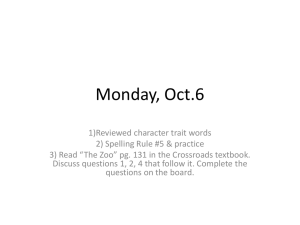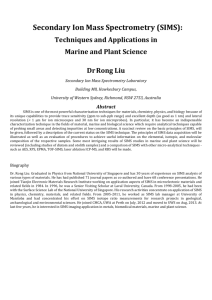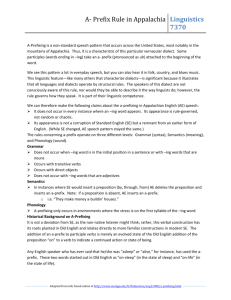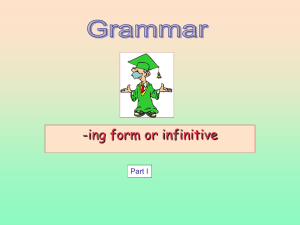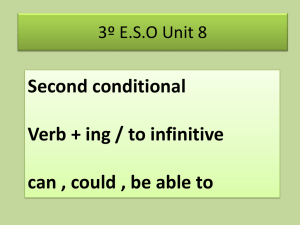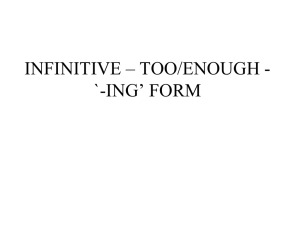Inceptive aspect in Germanic
advertisement
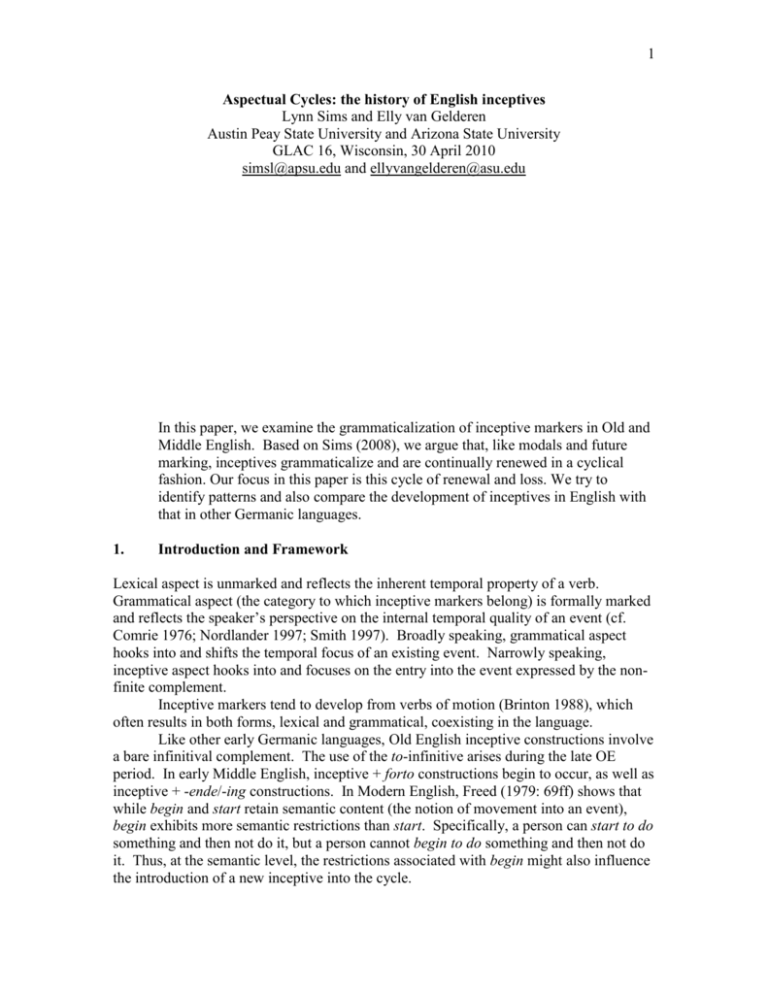
1 Aspectual Cycles: the history of English inceptives Lynn Sims and Elly van Gelderen Austin Peay State University and Arizona State University GLAC 16, Wisconsin, 30 April 2010 simsl@apsu.edu and ellyvangelderen@asu.edu In this paper, we examine the grammaticalization of inceptive markers in Old and Middle English. Based on Sims (2008), we argue that, like modals and future marking, inceptives grammaticalize and are continually renewed in a cyclical fashion. Our focus in this paper is this cycle of renewal and loss. We try to identify patterns and also compare the development of inceptives in English with that in other Germanic languages. 1. Introduction and Framework Lexical aspect is unmarked and reflects the inherent temporal property of a verb. Grammatical aspect (the category to which inceptive markers belong) is formally marked and reflects the speaker’s perspective on the internal temporal quality of an event (cf. Comrie 1976; Nordlander 1997; Smith 1997). Broadly speaking, grammatical aspect hooks into and shifts the temporal focus of an existing event. Narrowly speaking, inceptive aspect hooks into and focuses on the entry into the event expressed by the nonfinite complement. Inceptive markers tend to develop from verbs of motion (Brinton 1988), which often results in both forms, lexical and grammatical, coexisting in the language. Like other early Germanic languages, Old English inceptive constructions involve a bare infinitival complement. The use of the to-infinitive arises during the late OE period. In early Middle English, inceptive + forto constructions begin to occur, as well as inceptive + -ende/-ing constructions. In Modern English, Freed (1979: 69ff) shows that while begin and start retain semantic content (the notion of movement into an event), begin exhibits more semantic restrictions than start. Specifically, a person can start to do something and then not do it, but a person cannot begin to do something and then not do it. Thus, at the semantic level, the restrictions associated with begin might also influence the introduction of a new inceptive into the cycle. 2 In this paper, our approach is to be as descriptive as possible; theoretical issues, such as those below, will, hopefully, become clearer as more work is done in this area. Inceptives do not reduce to the extent of other auxiliaries; therefore, they do not fit easily into frameworks of grammaticalization, such as the cline in Table 1. _____________________________________________________________ Verb > Auxiliary > Clitic > Affix _____________________________________________________________ Table 1: Grammaticalization Clines 2. 2.1 Bi-clausal structures, necessary because of begin and start’s infinitival complement, are not intuitively right. It is unclear how a Minimalist framework would deal with inceptives in terms of features. If work on feature economy is in the right direction, e.g. van Gelderen (2008), we know that inceptives would have grammaticalzed motion features. These motion features might be a clue to the difference between begin and start in ModE. Old English Inceptive Competition In OE, several verbs are used to mark inceptive aspect. Sims (2008) provides the table reproduced below that shows the chronology of the most common inceptive markers. ________________________________________________________________________ Old English Middle English Early Modern English ______________________________________________________________________________ c700 c1000 c1200 c1400 c1600 onginnan → → → → → (use declines) aginnen → → → → → (1340: last textual example) ginnen / gin → → → → → (function varies; lost in eModEng) beginnan → → → → → → → → → → → (continues into ModEng) inginnan (in the Rushworth Glosses) fon (OE use rare) → (increase in ME) → → (does not continue past ME) gefon (does not continue into ME) onfon → → → (lost in eME) underfon (does not continue into ME—better translated as ‘undertake’) tacan → → → → → → → → (inceptive use ends in eModEng) start → → ______________________________________________________________________________ Table 2: The Use of Inceptive Markers in Earlier English (based on Sims 2008: 82) Typical examples of inceptive constructions are provided in (1) to (6), with (1) being perhaps the most common. Many differences can be attributed to regional variation, e.g. inginnan in (2) is Mercian appearing in the Rushworth Glosses, but certain clear differences in stage towards auxiliary-hood will appear. 3 (1) þa ongan ic ongemang oðrum mislicum & monigfaldum bisgum then began I among other variously & manifold troubles ðisses kynerices þa boc wendan on Englisc . . . this kingdom the book to translate in English . . . ‘then I began, among other various and manifold troubles of this kingdom, to translate the book into English’ (Pastoral Care Pref. 6.17; Sims 2008: 98) (2) seoðþan in-gann læran 7 cweþen doaþ hrewnisse forðon . . . afterward began to teach & to speak do repent because . . . ‘from then on [he] began to preach & to say, repent because …’ (Rushworth Matt 4:17; Sims 2008: 104) (3) . . . 7 ne beginnes cuoeða fader we habbað [abraham] . . . & not begin to say father we have [abraham] (Lindesfarne Luke 3.8; Sims 2008: 108) (4) Ða ongunnon ealle ða næddran to ceowenne heora flæsc Then begun all the snakes to chew their flesh and heora blod sucan and their blood to suck (5) (Ælfric Homilies 11.488; Sims 2008: 116) þa begunnon hi to cidenne mid micelre ceorunge then begun they to quarrel with great complaint ongeane þone ælmihtigan god against the almighty god (Ælfric Homilies 21.304; Sims 2008: 116) (6) he feng to rædene he began to deliberate (Ælfric 34.64; Sims 2008: 125 [from Callaway 1913: 41]) 2.2 Differences We begin with an overview of variation in Skeat’s (1887/1970) edition of The Gospel According to Saint Matthew in Anglo-Saxon, Northumbrian, and Old Mercian. As Table 3 shows, in the four versions of the Matthew gospel, there is a difference in the grammaticalization of –ginnan. _____________________________________________________________________ Lindisfarne Rushworth Corpus Hatton 950 Northern 980 Mercian 1000 W-Saxon 1150 W-Saxon bare inf with onon-/inon-/aon-/ato-inf with ----ge-V with on---_____________________________________________________________________ Table 3: Differences in Matthew with –ginnan 4 Looking at the inceptive variants of –ginnan in all of OE, we consider two differences to be interesting: (a) the phonological reduction and the use of the preterit form by some (b) the type of prefix on the pre-auxiliary and the morphology and syntax of the following verb Following Sims (2008), we argue that onginnan and aginnan show more characteristics of auxiliaries than beginnan. Onginnan reduces phonologically to aginnan, becomes a frozen preterit construction, and disappears during the ME period. Beginnan does not experience this reduction and continues into Modern English, where it ‘competes’ with a new verb start. Looking at the issue of preterit tense, OE onginnan is used mainly in the preterit, as in (7) to (9) (cf. Ogura 1997: 404). This is a sign of grammaticalization (note e.g. the grammaticalization of saw but not see in ModE., as described in van Gelderen 2004: 180190). (7) (8) (9) ða ongan he ærest herigean on him ðæt ðæt he fæstrædes wiste . . . then began he first to praise in them that which he fortitude knew ‘then he first began to praise what he knew was their steadfastness’ (Pastoral Care 32.212.7; Sims 2008: 98) Ongan þa ofstlice eorla menigu to flote fysan Began then speedily men many to sea to hasten ‘Then the band of men began to hasten to the sea’ (Elene 225a; Sims 2008: 117) geseah þa þone wind swiðne frohtade 7 þa in-gon sincan . . . saw then the wind strong afraid & then began to sink . . . ‘when [he] saw the strong wind, [he] became afraid & then [he] began to sink’ (Rushworth Matthew 14:30; Sims 2008: 104) Also, the preterit form of onginnan almost categorically occurs with the bare infinitive rather than the to-infinitive, which is another sign of closeness between the verbs. The on- prefix weakens during the OE period, as (10) shows. By early Middle English, the prefix becomes semantically empty and an inceptive notion is no longer an inherent feature of the prefix (cf. de la Cruz 1975; Hiltunen 1983; Brinton 1988). (10) 7 agynð beatan hys efen-þeowas. 7 yt 7 drincþ mid druncenum ‘and begins to strike his servants, and to eat and drink excessively’ (Corpus Matthew 24:49; Sims 2008: 105) In (10), aginne occurs with a bare infinitive and with a participle in (11). (11) . . . anginne gehealde na mid ege helle ac mid cristes lufan . . . begin to hold not with fear hell but with Christ’s love ‘[You] . . . begin to hold not with fear of hell but with love of Christ’ (BenRG1 36.15; Sims 2008: 109) 5 Conversely, beginnan frequently occurs with to-infinitive, as in (12). According to the OED (s.v. begin) beginnan was “very rare” and it is interesting that its complement is a to-infinitive. (12) þurh þa lufe he beginþ to healdenne swylce gecyndelice and gewunlice through the love he begins to hold such natural and common ‘through the love [of Christ] he begins to hold as if natural and innate’ (BenR 7.31.18; Sims 2008: 109) Finally, Wuth (1915: 54) and Brinton (1981: 90) argue that –ginnan forms cannot occur with prefixed verbs (i.e., ge-, for-, of-) because these prefixes mark perfective aspect. Thus, Wuth considers the single onginnan + ge-infinitive in Cynewulf to be scribal error. However, Sims (2008: 108-10) provides several examples of on/aginnan + gecomplement constructions from the Lindisfarne Gospels and The Rule of St. Benet and argues against scribal error. Sims also indicates that this is another area in which onginnan and beginnan differ: onginnan occurs with a prefixed complement while beginnan does not. As Table 4 shows, the on-prefixed variant occurs very frequently with the bare infinitive (96%) while the be-prefixed variant selects the to-infinitive (67%) (see Sims 2008: 113; Los 1995). ______________________________________________________________________ bare infinitive % to-infinitive % onginnan Alfred 246 99% 2 1% Ælfric 82 77% 25 23% Other texts 649 98% 10 2% Total onginnan 977 96% 37 4% aginnan Total other texts 28 85% 5 15% beginnan Alfred 0 -0 -Ælfric 19 26% 54 74% Other texts 9 75% 3 25% Total beginnan 28 33% 57 67% ____________________________________________________________________ Table 4: OE –ginnan Forms in Periphrastic Constructions (Sims 2008: 113; compiled from data in Callaway 1913: 279-287) To conclude this section: OE onginnan is the only form that shifts significantly (in terms of a grammaticalization cline): it becomes more restricted in uses (e.g. preterit and type of complement) and more phonologically reduced. As the inceptive meaning of the onprefix weakens during OE, the to-infinitive may initially come to strengthen or renew the notion of inceptive aspect associated with onginnan/aginnan, and then beginnan takes over. 3. Renewal and loss 6 3.1 Early Middle English In ME, begin and (a)gan continue but there are numerous new candidates, namely commencen (comsen and becomsen), proceden, fallen, grouen, setten, breken, and bresten. Begin becomes the most frequently used form, and it loses its bare infinitival complement at the same time (around 1200) that an –ing complement is introduced. In Early Modern English, start is also introduced as a verb, but it does not occur with other verbs until the 1800s. In the Modern English period, start seems to be the one grammaticalizing the quickest but interesting developments with begin are also occurring. We suggest that early ME gon/gan ‘began’, as in (13), was the successor of ongan but grammaticalized early to the point where it disappeared in Early Modern English. (13) þer he gon bulde castel swiðe strongne there he began build castle very strong ‘He began to build a very strong castle there’ (Layamon’s Brut, 3186) During the ME period, gan’s infinitival complement becomes more restricted, occurring mainly with the bare infinitive, as in (13). In Layamon’s (13th c.) text, gan is still very frequent. The forms are typically gon for the singular ‘began’ and gunnen for the plural ‘began’; the singular gan and plural gonnen, also with the meaning ‘began’, are less frequent. They are mainly followed by a bare infinitive, as in (14). However, surprisingly, the infinitive marker can still be robust (see Table 5), even a forto occurs, as in (15). (14) þat heore uolc gon waxen; and Bruttes gunnen wonien that their people began grow and Brits began wane ‘that their own people became stronger and the British weaker’ (Layamon’s Brut Caligula, 13472) (15) þer ich lai a sweuete. agan ich forto slepe As I lay in slumber, began I forto sleep ‘As I lay in slumber, I began to sleep’ (Layamon’s Brut Caligula, 12767; Sims 2008: 143) With biginnan, as in (16a. and 16b.), an infinitive marker is more common. (16) a. þa bigunnen blissen in Brutene to wunien then began joys in Britain to dwell ‘then happiness began to reign in Britain’ (Layamon’s Brut Caligula 14350) b. þo then bigan þar began there blisse for bliss for wonie in Brutayne live in Britain (idem, Otho version) 7 Layamon’s Caligula version has 146 instances of plural gunnen (4 of gunne and 2 of gonnen) and 222 of singular gon (and 1 of gun and 5 of gan) as opposed to 43 forms of bigun(nen) and bigon(nen). These numbers are given in Table 5. Bare to-infinitive -ing total 316 (83%) 64 (17%) 0 380 bigun(nen)/bigon(nen) 27 (63%) 14 (33%) 2 (5%*) 43 agon (agan once) 21 (100%) 0 21 gunne(n)/gonnen/gan/gon Table 5: 0 Inceptive complements in Caligula (*does not add to 100% due to rounding off) As in OE, forms without be- are typically followed by a bare-infinitive, as in (14), whereas bigun(nen) and bigon(nen) are followed by to-infinitives, as in (16a.) and (17), and two have an –ing, as we’ll see. (17) heo bigunnen to fihten they began to fight (Layamon’s Brut Caligula, 14132) In the mid 13th century, -ing complements are introduced, as in (18) and (19), both cited in Visser (1973: 1890). These reinforce the durative aspect and begin could be in an ASP position with the sentence being mono-clausal. (18) he sone bi-com in-to Brutlonde & anan bigon ræuinge uppen Basian þene kinge he soon came into Britain & immediately began pillaging over Basian the king ‘and soon he arrived in Britain and immediately began pillaging Basian’s land’ (Layamon’s Brut, Caligula 5267-5268; Sims 2008: 158) (19) Vmben ane stunde; heo bigunnen striuinge By a time; they began to fight/fighting ‘after a little while, they began to fight’ (Layamon’s Brut, Caligula 7765; Sims 2008: 159) Summarizing the early ME Layamon facts: (a) the OE differences between onginnan and beginnan continue to a certain extent (see Table 5), but (b) new complements arise The (on)ginnan form is lost by the end of ME and, before it was lost, it showed signs of grammaticalization. What we might expect is for the –ing option in (18) and (19) to grammaticalize further, like the bare infinitive before it. First, we see a real increase of begin + forto and begin + ing. Below, we suggest that start + ing is a competitor to begin + ing. These changes are represented as Figure 1. 8 Old English Middle English Early Modern onginnan + infinitive → gan + infinitive → 0 beginnan + infinitive → → → → 0 beginnan + to-infinitive → → → → → → → → → → → beginnan + V-ing → → → → → → → → → → → start + infinitive → → → → start + V-ing → → → _______________________________________________________________________ Figure 1: From Old to Middle English 3.2 Middle English begin Of the approximately 46 occurrences of beginnen in Ormulum (c1200), none occur with a bare infinitive (see also Ogura 1997). At the same time, as we have shown for Layamon, other infinitival complements occur with beginnen. While Visser and the OED (s.v. begin) indicate that begin + forto constructions are attested from a1300, examples (15), (20), and (21) show that the construction was used in early ME. (20) Forr nollde nohht te Laferrd Crist Biginnenn forr to spellenn, For would-not not the Lord Christ Begin for to preach ‘For the Lord Christ would not begin to preach’ (Ormulum 10886-887; Sims 2008: 155) (21) [when] þeo hefden alles bigunnen uorto speaken (c1225 Ancr. R (EETS 1952) 31, 23; Visser 1973: 2047) Also, OE and ME occasionally use constructions that include an aspectual marker to express continuous events. A similar ME construction, now considered dialectal, occurs with begin, as in (22). (22) Quen þai vnderstode þis worde A soruing þai bigan When they understood this word on-sorrowing they began ‘When they understood this word, they began (a)grieving’ (Cursor Mundi 15518; Visser 1973: 1890; Sims 2008: 159) In (23), Gower (c1390) uses an unambiguous begin + participle construction to express movement into a continuous event. (23) this holy man To me spekende thus began and saide: Benedicite this holy man to me speaking thus began and said: Benedicite ‘this holy man began speaking to me thusly and said, Benedicite’ (Gower, Confessio I, 203; Visser 1973: 1890; Sims 2008: 160) 9 Example (24), from c1400, includes a participial form. Visser notes that the corresponding form which occurs in the Vernon manuscript uses the –ing affix (sittinge) rather than –ynde. (24) . . . fro þat he bi-gan syttynde in a churche-ȝerd Amonges oþer men . . . . . . from that he began sitting in a church yard amongst other men . . . ‘. . .from the time that he began sitting in a church yard with other men . . .’ (Life St. Alexius, Laud MS, 108, [ed. Furnivall] 41.178; Visser 1973: 1890; Sims 2008 160) The next four examples are from c1410, c1464, 1532-33, and c1553, respectively (Sims 2008: 160-61 from Visser 1973: 1890). According to Visser, there is a “gap in the evidence” between the years 1553 and 1813. We need to look into this gap more but for the moment assume that it is accidental. (25) Sore begeringe [read bikeringe] they begonne sore bickering they began ‘they began bickering sorely’ (Lovelich, History Holy Grail [EETS] 20, 244) (26) Tubal-Cain . . . began first graving in metallis Tubal-Cain . . . began first engraving in metallis ‘Tubal-Cain first began engraving in metal’ (Capgrave, Chron. [ed. Hingeston] 8) (27) some of them begin already giuing no credence to no man but if it be . . . some of them begin already giving no credence to no man but if it be . . . ‘some of them already stopped giving any credence to any man unless he be . . .’ (St. Th. More, Wks [1557] 687 D 19) (28) Now Roister Doister will no more wowying begin Now Roister Doister will no more wooing begin ‘Now Roister Doister will not begin courting any more’ (Udall, Roister IV, viii) The inceptive aspect associated with the above begin + -ing/-ende examples appears to be no different from that in the Jane Austen (1813) example below and the later examples (up to 1962) provided by Visser (1973: 1890). (29) Unable to contain herself, she began scolding one of her daughters (J. Austen, Pride & Prejudice II. 10; Sims 2008 : 162) Jane Austen (at least in Pride & Prejudice) does not use inceptive start; instead, the toinfinitive is preferred over the –ing complement (began V-ing 5; begin* V-ing 1; began to 24; begin* to 8). 10 3.3 Early Modern and Modern English At Table 6 shows, both –ing as the verbal complement inflection and inceptive start, the possible reinforcement for begin, have a slow start. The Helsinki Corpus EMOD period covers the period from 1500 to 1710 (Kytö & Rissanen 1988). In this corpus, start does not appear and begin appears only with a to complement. begin* to 39 begin* -ing 0 began to 54 began –ing 0 start* to start* –ing 0 started to 0 started –ing 0 0 Table 6: Inceptives in HC-EMOD (588,820 words) The situation in Shakespeare’s First Folio is the same: inflected forms of the present and past of begin occur followed by a to infinitive, although the present is more frequent (59 inflected begin, 13 inflected past tense, and 4 participle forms). Again there are no instances of –ing complements or of inceptive start (though start occurs 56 times as an intransitive, with meanings such as ‘rush forth’ and a possible ‘begin’, as in (30)). (30) Do but start an eccho with the clamor of thy drumme. (1595, Shakespeare, John, V.ii.167; Sims 2005) While the origin of start is not exactly clear and its semantic history is complex, it is considered a motion verb. Early periphrastic constructions involving start do not express inceptive aspect, but they do demonstrate its inherent notion of movement and its grammatical-like function, as (31) and (32) indicate. (31) who so is nexte shulde sterte to geete her hoole fro hem ‘whoever is nearest should move to guard her den from them’ (c1410, Master of Game, xxxiv; Sims 2005) (32) Atte the dredfulle day he wolle axe acomptes where as there shalle none sterte to yelde ansuere ‘On that dreadful day he will demand account and none shall escape to yield an answer’ (1450, Knight de la Tour (1868) 113; Sims 2005) From the late 1500s to the1800s, we find examples of start being used as a lexical verb with the sense of ‘to initiate/begin’, as in (30) and (33). (33) He started a discourse of a talk he hears about the town. (1666, Pepy’s Diary, 24 June; Sims 2005) The result of start’s semantic shift appears to make it available for use in grammatical constructions similar to the begin + infinitive construction. Thus, in the mid-1800s, we 11 begin to see textual examples of start + V-ing and start + (in) to-V constructions, as examples (34) to (39) show (from Sims 2005). (34) I had before this written to Rose how we had best start agitating (1833, J. H. Newman, Letters & Correspondence) (35) however, after he started dictating directly to the typewriter (1869, Henry James, Pyramus & Thisbe) (36) Alexander finally started rehearsing the play in December (1893, Henry James, Guy Domville) (37) and I started to hear Sylvie’s sudden bark in the garden (1853, C. Brontë, Villette) (38) I saw a dog of this kind start to nibble at a flea (1869, Mark Twain, Innocents Abroad) (39) There would be no chance of crossing it [the river] for some days . . . even if it started to go down at once. (1891, C. Roberts, Adrift Amer., 181) In the Modern English period, as in Table 7, it seems as if the new form start is closer to grammaticalizing. The present tense of the verb begin followed by the to-infinitive is by far the most frequent and this is evidence of less grammaticalization. Start, on the other hand, occurs more frequently with –ing and could be mono-clausal. begin* to 37 begin* –ing 5 began to 2 began –ing 1 start* to 0 start* –ing 11 started to 0 started –ing 6 Table 7: Inceptives in CSE-FACT (161,050 words) Table 8 draws upon a slightly larger corpora, the half million White House Conversation corpus. The results show the same trend but not quite as drastic as Table 7. begin* to 55 begin* -ing 8 began to 11 began –ing start* to 11 start* –ing 18 started to 7 started –ing 10 Table 8: 6 Inceptives in CSE-WH Tables 7 and 8 suggest that start prefers an –ing complement and that begin prefers a to-infinitive. Recall also that with OE –ginnan, the preterit form fossilizes. The same might be happening with start: the present forms appear to favor begin (79% in Table 7; 68% in Table 8); and the preterit forms lean toward start (67% in Table 7; 50% in Table 8). 12 In terms of cycles, started + -ing seems to be replacing the earlier began + -ing construction (in both the present and past tenses), and/but begin (both present and past) still—since the Old English period—seems to prefer the to infinitival complement. However, as Table 9 shows, begin + to- constructions have declined noticeably in the past twenty years. Using the Corpus of Contemporary American English, over 400 million words collected between 1990 and 2009, the evidence of change is as follows. The numbers represent instances per million words. It seems as if all forms of begin are losing ground, but especially those with to-infinitives. This is true across all genres. Start on the other hand seems to be gaining ground. 1990-94 1995-99 2000-04 2005-09 began to 105.43 93.72 88.19 81.11 began *ing 64.45 65.87 70.13 64.57 begin* to 101.60 91.02 82.14 73.23 begin* *ing 24.20 24.34 24.34 20.51 beginning to 37.18 31.11 29.22 25.97 started to 32.67 34.20 34.65 39.01 started *ing 63.39 75.94 84.04 90.44 start to 16.89 19.87 20.82 22.47 start *ing 52.95 59.81 60.13 64.43 starting to 18.15 21.44 23.52 25.53 starts to 14.98 15.61 14.37 12.70 starts *ing 13.24 15.26 14.91 13.68 Table 9: Begin and start in COCA (per million words) 4. Cycles In Figure 2, we show some of the changes that occur regarding the –ginnan and start inceptives. In this figure, we have not taken the difference between present and past tense into account. We think (as also argued by Ogura (1997) for onginnan and van Gelderen 2004 for saw) that it is the preterit form that is the first to grammaticalize. This forms a pattern with other grammaticalizations. 13 Middle English begin to-/begin -ing OE ongin + bare infinitive Early ModE (begin + to-infinitive) begin to-/begin –ing (start to-/start –ing) ?? Modern English start to-/start -ing begin to-/begin –ing Figure 1: 5. The Inceptive Cycle Other Germanic languages In addition to the cyclical pattern of inceptives in English, we are interested in how this pattern compares to the development of inceptives in other Germanic languages. While we continue to look at other Germanic languages, the following provides our preliminary data. The use of –ginnan to mark inceptive aspect is well documented in early Germanic languages, and standard OE dictionaries list the following counterparts to Old English –ginnan: Gothic duginnan, as in (40) and (41), Old Saxon beginnan, as in (42) and (43), and Old High German biginnan, as in (44) to (46). (40) dugann Iesus qiþan þaim manageim bi Iohannen ‘Jesus began to speak to the many with John’ (Matthew 11.7) Gothic (41) jah dugunnun þagkjan ‘They began to consider’ (Luke 5.21) Gothic (42) Thô begunnun thea uuîson man seggean iro sueðanos ‘Then began the wise men to speak of their dreams’ (Heliand 687b-688a) Old Saxon (43) He began is liði hrôrien ‘he began his limbs to move’(Heliand 4099b) Old Saxon (44) pegont er sie leren Began he them to teach (Georgslied 52) Old High German 14 (45) bigonda tho leidezen inti forsahhan inti sueran quedenti Old High German ‘then he began to abominate and to curse and to swear, saying’ (Tatian 188.5) (46) inti so her bigonda sinkan ‘and when he began to sink’ (Tatian 81.4) Old High German Inceptives in other Germanic languages occur with the same types of verbs (i.e., process verbs, verbs of communication) as OE inceptives (cf. Brinton 1981: 99-108). However, unlike OE, the -ginnan forms in other early Germanic languages occur only with a bare infinitive. In Old Norse, there are two verbs, taka and nema. Faarlund (2004: 159; 278-9) mentions taka and suggests a transition is obvious from main verb taka in (47) to auxiliary in (48). (47) hon tok at grata ‘she began to cry’ (48) er hausta tok when become-fall began ‘when autumn began to fall’ Old Norse (Njal’s Saga 18.1, Faarlund 2004: 278) Old Norse (Hkr II 263-4, Faarlund 2004: 279) We also found forms of nema in the Poetic Edda, as in (49) and (50), but Faarlund does not mention this verb. The Poetic Edda also has taka, as in (51). (49) (50) (51) 6. þa nam ek frævask ok frodr vera then began I thrive and wise be ‘then I began to thrive and to gain knowledge’ þat nam at mæla mær fjörsjuka that began to speak maiden sick ‘The sick maiden began to speak’ bruðr mæla tekr bride speak begins ‘The bride begins to speak’ Old Norse (Havamal 141) Old Norse (Oddrunargratr 8) Old Norse (Gripisspa 16, Kuhn 1968: 147) Conclusion In this paper, we have examined replacements and renewals of the inceptive in English. The cycle in Figure 2 summarizes the developments. We found that inceptives typically allow two possibilities: one that creates distance between the start of the action and the actual action (done through a to-infinitive) and one where the beginning of the action is emphasized (done through an –ing). Ironically, the meanings of begin and start are such that we’d expect begin with an ing and start with to. As Freed (1979: 68; 71) says, “begin occurs in a more restricted 15 number of contexts than start”; “begin refers to the initial temporal segment of the nucleus of an event” while start “refers to the onset of an event”. Thus, one can ‘start to sneeze’ but stop it but not ‘begin to sneeze’ and then stop it. Start with an –ing complement loses this possibility. This is what she means by the wider context of start. References Brinton, L. (1981). The historical development of aspectual periphrases in English. Doctoral dissertation, University of California, Berkeley. Brinton, L. (1988). The development of English aspectual systems: Aspectualizers and post-verbal particles. Cambridge: Cambridge University Press. Callaway, M., Jr. (1913). The infinitive in Anglo-Saxon. Washington, D. C.: Carnegie Institution of Washington. Comrie, B. (1976). Aspect: An introduction to the study of verbal aspect and related problems. Cambridge: Cambridge University Press. De la Cruz, J. M. (1972). Transference and metaphor in Middle English verbs accompanied by a locative particle. Orbis, 21, 114-135. Freed, A. (1979). The semantics of English aspectual complementation. Dordrecht: D. Reidel. Funke, O. (1922). Die Fügung ginnen mit dem Infinitive im Mittelenglischen [The construction ginnen plus infinitive in Middle English]. Englische Studien, 56, 1-27. Gelderen, E. van (2004). Grammaticalization as economy. Philadelphia: John Benjamin's Publishing Company. Gelderen, E. van (2008). Where did Late Merge go? Grammaticalization as Feature Economy, Studia Linguistica, 287-300. Gonda, J. (1962). The aspectual function of the Rgevedic present and aorist. Disputationes RhenoTrajectinae. The Hague: Mouton de Gruyter. Hiltunen, R. (1983). The decline of the prefixes and the beginnings of the English phrasal verb. Turku: Turun Yliopisto. Kytö, Merja & Matti Rissanen 1988. "The Helsinki Corpus of English Texts". In: Ossi Ihalainen et al. (eds), Corpus Linguistics: Hard and Soft 169-79. Amsterdam: Rodopi. Los, B. (2000). Onginnan/beginnan with bare and to-infinitive in Ælfric. In O. Fischer (Ed.), Pathways of change: Grammaticalization in English (pp. 251-274). Philadelphia: John Benjamin’s Publishing Company. Los, B. (2005). The rise of the to-infinitive. Oxford: Oxford University Press. Mitchell, B. (1985). Old English syntax. Vols. I and II. Oxford: Clarendon Press. Nordlander, J. (1997). Towards a semantics of linguistic time. Sweden: Umeå University Press. Ogura, M. (1997). On the beginning and development of the begin to construction. In J. Fisiak (Ed.), Studies in Middle English linguistics (pp. 403-428). Berlin: Mouton de Gruyter. Sims, L. (2004). The function of ‘gan’ in Layamon’s ‘Brut’. Unpublished paper. Sims, L. (2005). Arrested Grammaticalization: A diachronic analysis of ‘start’. Conference presentation. SHEL 4. Sims, L. (2008). The grammaticalization of ingressive aspect in early English. Doctoral dissertation, Arizona State University. Smith, C. (1997). The parameter of aspect. Dordrecht: Kluwer. Terasawa, Y. (1974). Some notes on ME gan periphrasis. Poetica, 89-105. Visser, F. (1969). An historical syntax of the English language (Part 3, First Half). Leiden: E. J. Brill. Visser, F. (1973). An historical syntax of the English language (Part 3, Second Half). Leiden: E. J. Brill. Wuth, A. (1915). Aktionarten der Verb bei Cynewulf [The aktionsart of the verb in Cynewulf]. Weid i. Thüringen: Thomas & Hubert.
